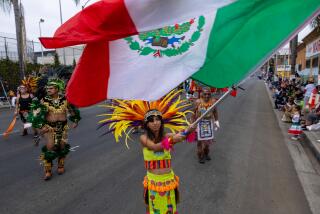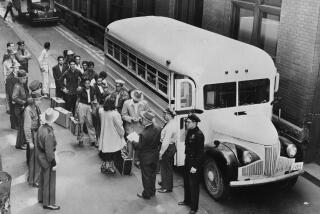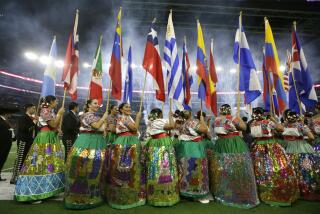Plan for national Latino museum advances
WASHINGTON — Four years ago, a museum celebrating the history and culture of Native Americans opened at the east end of the National Mall. Within a decade, one honoring the contributions of African Americans will be erected on the west end, near the Washington Monument. Yet Latinos, the nation’s largest and fastest-growing minority, have no museum of their own in the nation’s capital.
But the National Museum of the American Latino came one step closer to reality Tuesday when the House, by a vote of 291 to 117, approved legislation that includes creation of a commission to study the feasibility of building such a facility.
There’s no timeline for construction. Neither the museum’s location nor the scope of its collection has been determined. Still, a host of groups praised the vote.
“Latinos were a part of American history before the landing at Plymouth Rock,” said Arturo Vargas, executive director of the National Assn. of Latino Elected & Appointed Officials. “This is going to be a long process, but Latinos aren’t going anywhere, and we’re going to see this through.”
The measure is included in a larger bill on natural resources that passed the Senate, 91 to 4, this month. It authorizes creation of a bipartisan 23-member commission that will spend $3.2 million over two years to come up with recommendations and sponsor a conference where interested individuals or groups can submit ideas and develop a fundraising plan.
The driving force behind the proposal is Rep. Xavier Becerra (D-Los Angeles), who introduced the plan almost five years ago. “Like any good idea in Washington, it takes a few years to percolate to the top,” he said. “It’s a good idea whose time has come.”
The push for the new museum comes in the midst of a continuing debate about the future of the , the iconic two-mile stretch from the Capitol to the Lincoln Memorial that includes museums, memorials and green space. Prompted by concerns that the mall was becoming too cluttered, Congress in 2003 designated land where future construction is prohibited.
The National Coalition to Save Our Mall welcomes the Latino museum commission as long as it takes the time for careful analysis with public comment. The construction should be part of a rethinking about the grand plan of the mall, said Judy Scott Feldman, the coalition’s president.
“The National Mall, which was intended since 1791 as a public open space, a public park, a place for the people, has increasingly become a memorial and museum park,” Feldman said. “We have to allow it to continue to evolve without destroying the historic mall.”
The commission also will recommend whether the museum should stand alone or become part of the Smithsonian Institution, which includes 19 museums, nine research centers and the National Zoo. The ultimate decision on that issue will be made by Congress, said Linda St. Thomas, a Smithsonian spokeswoman.
Both the National Museum of the American Indian and the National Museum of African American History and Culture are part of the Smithsonian. Vargas says he wants the Latino museum to have the added cachet that comes with being affiliated with the Smithsonian.
“For it not to be would raise serious concerns from the community as this process develops,” he said.
Becerra said the bipartisan coalition that sponsored the measure declined to tell the commission what it preferred. That way, he said, experts can come up with the best proposal. “Good minds and good will to come up with some good answers,” he said.
Maggie Rivas-Rodriguez, director of the U.S. Latino and Latina WWII Oral History Project at the University of Texas in Austin, said Latinos should be included in more Washington exhibitions.
“It’s equally important to look at how Latinos are represented in the other national museums,” she said. “It’s just been ignored for too long.”
--
More to Read
The biggest entertainment stories
Get our big stories about Hollywood, film, television, music, arts, culture and more right in your inbox as soon as they publish.
You may occasionally receive promotional content from the Los Angeles Times.










